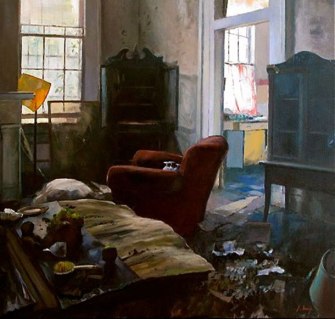I had already done some research on artists that had included or focus on domestic interiors in their work before starting quick sketches around the house. However, during this research point I have chosen to research other artists.
One of the first artists I came across and wanted to research further was Charles Hardaker and his series of paintings of the interior of his art studio. One such painting, Open Door – The Blue Coffee Pot (Fig 1) is an oil painting, predominantly white, with bold and confident brush strokes. A canvas rests on the floor and post notes cover the walls. A jacket hangs behind the door (maybe the artists) as you are able to put yourself in the room, drawn by the intrigue to see what is beyond the open door. The room is lit by sun light entering from the left and reflecting on the objects in the room. His use of light, shadows and tone and the simplicity of a blue coffee pot brings this piece to life me.

Charles Hardaker
Julyan Davis, born in Britain and living in America, has concentrated on capturing glimpses into the past life of buildings; be that a country mansion (Fig 2), farmhouse or bank (Fig 3). There are no pretty scenes of sun filled rooms, flamboyant decorations or highly polished floors. He paints rooms with faded, peeling walls, remnants of furniture shoved at odd angles, and random objects on the floor. You are able to sense an abandonment and perhaps the smells that linger within. Yet equally you are left wondering who may have lived there, or why they may have left their personal possessions, or why the bank closed. A contrast from the simplistic, uncluttered studio captured by Charles Hardaker (Fig 1).


David Hockney, My Parents (1977) (Fig 4) depicts an orderly and structured scene. In this work, painted a year before his father’s death, Hockney’s style had shifted towards a closer study of human behaviour. His mother poses, attentive and graceful as if posing for a photograph, while his father, somewhat oblivious to his involvement, continues to read his magazine, noting that he may have moved his chair into the centre of the room to catch the sin light to aid his vision. You are able to sense the couple are living in a modern house which they have yet adjusted to. The mirror in its wooden frame appears as if it’s a relic from their past and out of place alongside the 1970s wheeled sideboard and folding chairs.

David Hockney
Between 1984 – 1987 Hockney embarked on the ‘moving focus’ series (Fig 5). Using colour lithograph printed from nine aluminium plates, crayon, tusche with hand-painted wood and plaster frame, acrylic. There is a stark contrast to the style, technique and order from Fig 4 – My Parents. Here, the angles, proportions and lines distort the viewpoints within the same picture. There is clear disparity of perspective and foreshortening as Hockney looks to push the boundaries of perception. The distortion of symmetry is exasperated by the exclusion of tone or shadows.

David Hockney
Having viewed and compared a number of artist during this research by far my favourite is the Italian artist Matteo Massagrande and his series of empty building interiors. The Albemarle gallery likens his technique to that of an old master, but less romantic. You can not help but to be absorbed by his honest depiction of empty buildings, void of life as if waiting to deteriorate beyond repair. Once full of life, these rooms are now exhausted by the centuries of life running across the floor boards; births, deaths and parties. Reaching the end of its life and wanting to deteriorate peacefully and gracefully, as the floor boards are consumed by dry rot and rising damp penetrates the walls. The long shadows casting the only light and glimmer of life into this empty shell.
“Despite his talents, these images are not impressive swan songs to moments past, instead they feel far more like we are sharing the final intimate moments of a room and catching a final haunted glimpse at the fleeting beauty that remains”.
